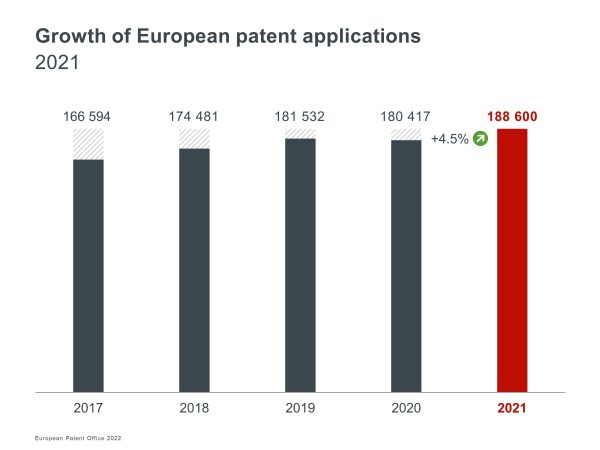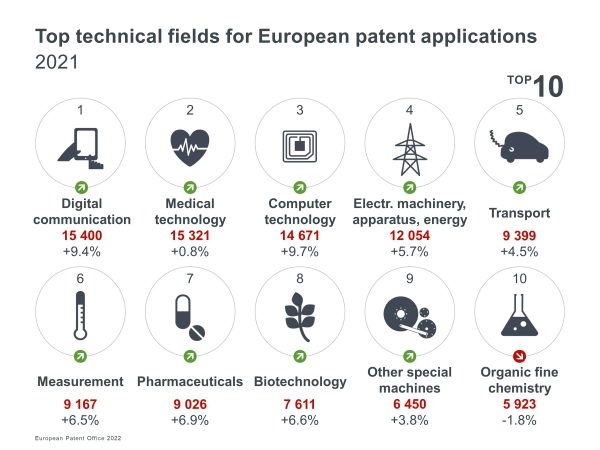Publications, press articles, rankings, awards
Record Filings at the European Patent Office in 2021
Despite the pandemic filings of European patent applications increased again. 188 600 patent applications were received by European Patent Office (EPO) in 2021, which is an increase of 4.5% in comparison to the previous year.
This is the highest number of applications ever filed in one year. The EPO’s Patent Index 2021 shows that patent filings rebounded significantly last year after a slight dip in 2020 (-0.6%).
In general the number of patent applications is seen as an early indicator of how the budgets of research and development investments of companies worldwide evolve. 

Source website of EPO
For applications in 2021 the top countries of origin were the US (25% of total filings), Germany (14%), Japan (11%), China (9%) and France (6%). Wherein patent applications are concentrated in a few countries, with five countries accounting for 64% of European patent applications in 2021, and the top 20 countries accounting for 95%.
The strongest growth in patent applications at the EPO in 2021 was happened due to filings from China (+24% in comparison to 2020) and the US (+5.2%). Applications from South Korea were also increased in 2021 (+3.4%), while Japan experienced a slight decrease filings (-1.2%). Patent applications from the 38 European Patent Organization countries experienced an slight increase last year (+2.8%). However, the number of applications from Europe continued to decline, falling from 50% of the total in 2013 to 44% in 2021. This trend shows that the European market is considered as relevant to companies outside Europe. Especially companies from Asia, seek to protect their inventions on the European market.
In accordance with the general numbers Huawei was the leading patent applicant at the EPO in 2021 (as in 2019), wherein Samsung, and LG were in second and third place. Ericsson and Siemens both moved up a position, to fourth and fifth respectively. The top ten includes four companies from Europe, two from South Korea, two from the US, and one from each of China and Japan.
This IP Alert is for information purposes only and does not constitute legal advice.
Record Filings at the European Patent Office in 2021
Despite the pandemic filings of European patent applications increased again. 188 600 patent applications were received by European Patent Office (EPO) in 2021, which is an increase of 4.5% in comparison to the previous year.
Which Nationality for a patent with unitary effect?
The patents’ nationality in case of joint ownership is determined by Article 7 of Regulation 1257/2012 which states:
Transfer of IP rights for free: the downside of gratuity
The transfer of intellectual property rights free of charge must be qualified as a donation, and as such must comply with the requirements specific to the matter (Decision of the Paris Court of Justice, February 8, 2022, No. 19/14142).
This case involved a trademark and Community designs owned by two individuals, Mr. X and Mr. Z. The rights were transferred in 2015 to company A, of which Mr. Z is the sole partner and manager.
In 2018, Mr. X criticized the transfer that took place in 2015 and sued Mr. Z and the company A for nullity of the transfer.
The Paris Court of Justice granted Mr. X’s requests and ruled that:
- The trademark and design assignment shall be requalified as a donation;
- The contract is void since it did not comply with the formalities imposed by Article 931 of the Civil Code.
The reclassification as a donation is justified by the fact that the contract concluded in 2015 explicitly entails the transfer of ownership of the trademark and designs “free of charge”.
With respect to the formalism to be observed, article 931 CC provides that “All acts involving inter-vivos donation shall be executed before a notary in the ordinary form of contracts; and a copy of the same shall remain noted, under penalty of nullity”
The case law allows two exceptions to this formalism. The first is the case of manual donation which require the physical delivery of the thing given. The second concerns disguised or indirect donation, for which it is accepted that the conditions of form follow the act from which they take on the appearance.
The code of the intellectual property does not provide for any additional exemption, but only that the transfer of property must be done in writing (article L. 714-1, paragraph 4 of the CPI in its then drafting)
In this case, the things transferred being intangible rights and therefore not susceptible of physical delivery, and the deed of transfer clearly mentioning that the transfer of ownership of the trademark and the models “free of charge”, the contested deed could not benefit from either of the two exemptions.
The court rightly concluded that it was therefore, by definition, an undisguised donation of intangible rights, so that it should have been concluded before a notary. The assignment contract is therefore declared null and void.
The transfer in question concerned physical donors, but an identical solution could have been pronounced, in our opinion, if it had been a question of legal entities as donors. Indeed, the article 902 of the CC provides that “All persons may dispose of and receive either by donation inter-vivos or by will, except those whom the law declares incapable of doing so”, which does not exclude legal entities. The Court of Cassation (C. Cass, com., May 7, 2019, appeal n ° 17-15.621) has confirmed such an assessment.
We recommend to be particularly vigilant when transferring your intellectual property rights, and in particular in the case of intra-group transfers for which it may be tempting to avoid the payment of a price for the transfer. LAVOIX’s team of experts are available to assist you in these procedures.
National, regional and international offices to implement the standard WIPO ST.26 for the sequence listings as of july 1, 2022
The Committee on WIPO Standards (CWS) adopted new WIPO Standard ST.26, which represents nucleotide and amino acid sequences listings in XML, replacing WIPO Standard ST.25.
The representation of sequence listings in XML format rather than TXT format intends to improve access to international sequence databases. The new standard further harmonizes sequence listing practice among patent offices and requires mandatory annotation of additional sequence types (nucleotide analogues, D-amino acids, branched sequences), so that more sequence data will be searchable.
The filing date (not the priority date) is the reference date that determines if the new ST.26 rules apply. Refiling a sequencing listing when a divisional application is made is a matter of national or regional law. As of today, the EPO is understood to require filing a divisional application filed on or after July 1, 2022 in the new ST.26 format.
A newly developed global software tool “WIPO Sequence” that enables the preparation amino acid and nucleotide sequence listings according WIPO Standard ST.26 is provided on the WIPO homepage.
More details on the standard WIPO ST.26 may be found under the WIPO and EPO websites.

